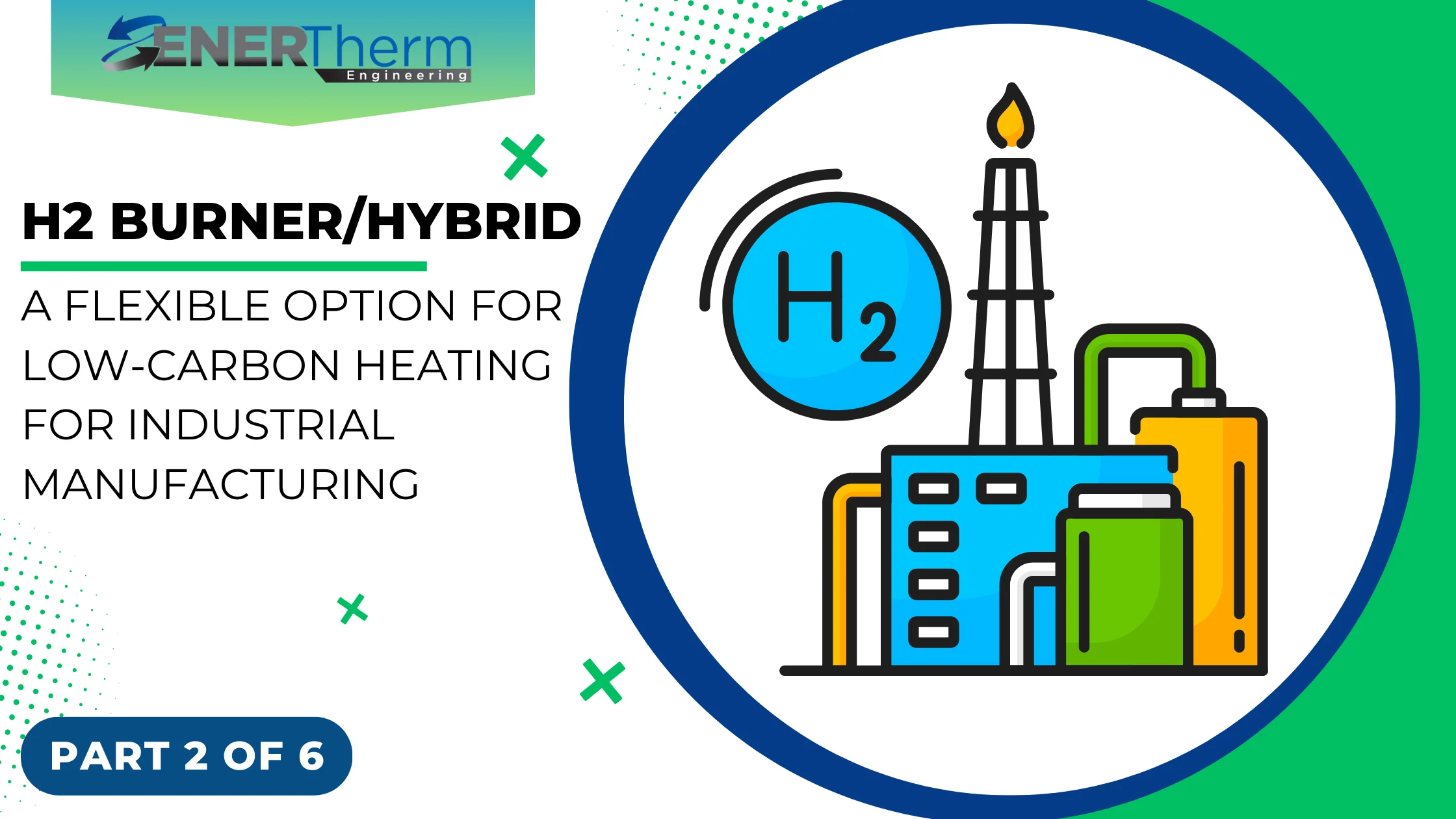What are H2 burner/hybrid systems and what are they used for in industrial manufacturing?
H2 burner/hybrid systems are innovative technologies that utilize hydrogen, or hydrogen blends, as fuel for heating appliances like boilers or furnaces. Hydrogen, denoted as H2, is recognized as a clean and renewable energy source, offering several methods of production.
The most environmentally friendly approach is the electrolysis of water, which uses electricity generated from renewable sources, such as wind or solar power. This method stands as the only truly ‘green’ way to produce H2, given that the power source is solely based on renewable energy.
Furthermore, H2 can be combined with natural gas to create what are known as hydrogen blends. These blends can be integrated into the existing gas infrastructure and appliances, requiring minimal modifications. This capability significantly boosts the versatility and sustainability of our current energy systems, marking a promising step towards a cleaner future.
Hypothetical Cost and Savings Analysis
To illustrate the impact of such systems, let’s consider a hypothetical scenario with a company named FoodCo, which operates an industrial bakery. They use large ovens heated by natural gas burners, which constitute a significant proportion of their operating costs. FoodCo is planning to transition to a fuel blend composed of 20% hydrogen and 80% natural gas.
Fuel Savings:
- Hydrogen has about one-third of the energy content of natural gas per unit of volume. However, when it is burned in a mixture with natural gas, it can make the combustion process more efficient due to its higher flame speed and lower ignition energy. This means that for the same volume of fuel, the hydrogen-natural gas blend could provide more heat than pure natural gas. Increasing the efficiency by 10%.
- If FoodCo’s annual natural gas bill is £1,000,000, the introduction of hydrogen could reduce this to £900,000 due to the improved efficiency, leading to annual savings of £100,000.
Capital Costs:
- Transitioning to a hydrogen-natural gas blend will require modifications to the burners and potentially other components of the ovens to ensure they can handle the new fuel mixture safely and efficiently. The exact costs will depend on the specifics of their equipment, but let’s estimate that the modifications cost £200,000.
- Furthermore, FoodCo will need to invest in new fuel delivery and storage infrastructure. Let’s assume they already have a natural gas pipeline and storage tanks and will only need minor modifications to handle the new fuel blend. This could cost another £100,000.
Evaluation:
- In this scenario, FoodCo’s initial investment to transition to a hydrogen-natural gas blend would be approximately $300,000. However, they could achieve annual savings of £100,000 on their fuel bill. Therefore, they could recoup their investment in three years and would save money in the long run.
- In addition, by using a hydrogen-natural gas blend, FoodCo would reduce their carbon emissions by about 20% (assuming the hydrogen is produced from renewable sources), contributing to their sustainability goals and potentially qualifying them for government incentives or credits.
The exact figures will depend on the specifics of FoodCo’s operations and the local cost of hydrogen and natural gas. However, the potential fuel savings and environmental benefits make this an option worth considering for many food production companies.
H2 burner/hybrid systems can be used for various purposes in industrial manufacturing, such as:
- Providing process heating, which involves raising the temperature of raw materials, intermediate products, or final products for various industrial processes, such as melting, forging, annealing, or curing. H2 burner/hybrid systems can provide process heating at different temperature levels, ranging from low (<100°C) to high (>1000°C), depending on the type and design of the burner or furnace.
- Providing steam generation, which involves producing steam for various industrial uses, such as power generation, heat exchange, or chemical reactions. H2 burner/hybrid systems can provide steam generation at different pressure and temperature levels, ranging from low (<10 bar and <200°C) to high (>100 bar and >600°C), depending on the type and design of the boiler or turbine.
How efficient are H2 burner/hybrid systems for industrial manufacturing?
The efficiency of H2 burner/hybrid systems for industrial manufacturing depends on various factors, such as the type of fuel (pure hydrogen or hydrogen blends), the combustion efficiency, and the emission factor.
The type of fuel refers to the composition of the gas that is used as a fuel for heating appliances. The main types of fuel are:
- Pure hydrogen, which consists of 100% hydrogen by volume. Pure hydrogen has a high heating value of 12MJ/m3, and a low density of 0.083 kg/m3. Pure hydrogen requires new or modified gas infrastructure and appliances, to ensure safety and performance.
- Hydrogen blends, which consist of mixtures of hydrogen and natural gas by volume. Hydrogen blends have lower heating values and densities than pure hydrogen, depending on the percentage of hydrogen in the blend. Hydrogen blends can be used in existing gas infrastructure and appliances, with minimal modifications, up to a certain limit (typically 20% to 30%).
Combustion efficiency refers to the percentage of fuel energy that is converted into useful heat energy by a heating appliance. The combustion efficiency depends on various factors, such as the type and design of the burner or furnace, the air-fuel ratio, the flame temperature, and the heat losses. The typical combustion efficiency for H2 burner/hybrid systems ranges from 80% to 95%.
The emission factor refers to the amount of CO2 that is emitted per unit of fuel energy consumed by a heating appliance. The emission factor depends on various factors, such as the type and composition of the fuel, the combustion efficiency, and the carbon intensity of the electricity grid. The typical emission factor for H2 burner/hybrid systems ranges from 0 kg CO2/MJ (for pure hydrogen produced from renewable electricity) to 56 kg CO2/MJ (for natural gas).
What are the pros and cons of H2 burner/hybrid systems for industrial manufacturing?
H2 burner/hybrid systems have several advantages for industrial manufacturing, such as:
- Lower emissions, which means that they can reduce greenhouse gas emissions from industrial manufacturing if using green hydrogen or low-carbon electricity grids.
- Compatibility with existing gas infrastructure is an important advantage of hydrogen energy. This compatibility means that hydrogen blends can use existing gas pipelines and appliances, with minimal modifications required, up to a certain limit. For instance, the UK network can accommodate a hydrogen blend of up to 20% without changing the existing piping network.
- Ability to switch between fuels, which means that they can use different fuels depending on availability and price, such as pure hydrogen, hydrogen blends, or natural gas.
However, H2 burner/hybrid systems also have some disadvantages for industrial manufacturing, such as:
- Safety risks are associated with hydrogen due to its flammability, volatility, and invisibility. This means they pose potential hazards for fire, explosion, or leakage. Furthermore, the inherent characteristics of a hydrogen flame, which doesn’t produce any thermal radiation, compound these risks because such flames are incredibly difficult to detect, thereby increasing the danger.
- Hydrogen production costs are primarily dependent on the availability and affordability of low-carbon electricity and water, as well as the efficiency and scalability of electrolysis technologies. It’s important to note that the current production cost of hydrogen is around 3-4 times that of natural gas, demonstrating the challenges associated with making this energy source more economically viable.
- Distribution challenges, which means that they require new or modified gas infrastructure and appliances, to ensure safety and performance if using pure hydrogen or high percentages of hydrogen blends.
- Consumer acceptance issues, which means that they require awareness and confidence among industrial users and stakeholders, as well as regulatory and standardisation frameworks.
How much can H2 burner/hybrid systems contribute to net zero and decarbonisation goals for industrial manufacturing?
H2 burner/hybrid systems can contribute significantly to net zero and decarbonisation goals for industrial manufacturing, by reducing the emissions from fossil-fuel-based heating systems. According to the Hydrogen Council, H2 burner/hybrid systems could cut global CO2 emissions from industrial manufacturing by 1.8 gigatons per year by 2050, compared to a business-as-usual scenario. This would represent a 18% reduction in industrial emissions, and a 5% reduction in global emissions.
The potential contribution of H2 burner/hybrid systems to net zero and decarbonisation goals for industrial manufacturing depends on various factors, such as the availability and cost of low-carbon electricity and water, the development and deployment of electrolysis and heating technologies, the adoption and diffusion of H2 burner/hybrid systems, and the policy support and incentives for hydrogen projects.
According to the Hydrogen Council, H2 burner/hybrid systems could constitute approximately 20% of cumulative CO2 emissions reductions in industry by 2050, compared to a business-as-usual scenario. This would require a rapid increase in the deployment of H2 burner/hybrid systems, from 50 megatons per year in 2020 to 300 megatons per year in 2030, and to 1,800 megatons per year in 2050. This would also require a significant increase in the installed capacity of H2 burner/hybrid systems, from 50 megawatts in 2020 to 300 megawatts in 2030, and to 1,800 megawatts in 2050.
Are H2 burner/hybrid systems future-proof for industrial manufacturing?
H2 burner/hybrid systems are likely to be future-proof for industrial manufacturing, as they can provide a flexible and low-carbon solution for heating systems. However, there are some challenges and uncertainties that need to be addressed, such as:
- Technological developments are needed to improve the efficiency, performance, reliability, and durability of H2 burner/hybrid technologies and reduce their costs, noise, and environmental impacts.
- Policy support, which is needed to create a favourable regulatory environment, provide financial support, remove market barriers, and raise awareness and confidence among industrial users and stakeholders.
- Hydrogen supply chain, which is needed to ensure the availability and affordability of low-carbon hydrogen production, distribution, and storage systems.
- Public awareness is needed to address the social and ethical concerns related to H2 burners/hybrid projects, such as hydrogen safety, quality, and sustainability.
To ensure that H2 burner/hybrid systems are future proof for industrial manufacturing, it is important to foster collaboration and coordination among different actors, such as policy makers, industry associations, manufacturers, suppliers, researchers, and end-users. It is also important to monitor and evaluate the performance and impacts of H2 burner/hybrid systems, and to share best practices and lessons learned. By doing so, H2 burner/hybrid systems can play a key role in achieving net zero and decarbonisation goals for industrial manufacturing.
Conclusion
H2 burner/hybrid systems offer a flexible and low-carbon solution for heating in industrial manufacturing. By utilizing hydrogen or hydrogen blends, these systems can reduce greenhouse gas emissions, provide fuel savings, and contribute to decarbonization goals. The efficiency of H2 burner/hybrid systems depends on factors such as the type of fuel, combustion efficiency, and emission factor.
While there are challenges and uncertainties to address, such as technological developments and policy support, H2 burner/hybrid systems hold promise for a cleaner and more sustainable future in industrial manufacturing. By fostering collaboration and monitoring performance, these systems can play a significant role in achieving net zero and decarbonization targets.
In summary, H2 burner/hybrid systems offer an innovative pathway towards reducing emissions and increasing energy efficiency in industrial manufacturing, paving the way for a more sustainable and environmentally friendly future.

